weight FIAT DOBLO COMBI 2017 2.G User Guide
[x] Cancel search | Manufacturer: FIAT, Model Year: 2017, Model line: DOBLO COMBI, Model: FIAT DOBLO COMBI 2017 2.GPages: 300, PDF Size: 24.91 MB
Page 147 of 300

WARNING
22)For diesel engines, use only diesel fuel
for motor vehicles in accordance with
EN590 European specifications. The use of
other products or mixtures may damage
the engine beyond repair and
consequently invalidate the warranty, due
to the damage caused. If you accidentally
introduce other types of fuel into the tank,
do not start the engine. Empty the tank.
If the engine has been run for even an
extremely limited amount of time, you must
not only drain the fuel tank, but the rest of
the supply circuit as well.
23)Do not approach naked flames or lit
cigarettes to the fuel tank filler: fire risk.
Keep your face away from the fuel filler to
prevent breathing in harmful vapours.
SAVING FUEL
Some useful tips are given below for
fuel saving and reducing harmful
emissions of CO2 and other pollutants
(nitrogen oxides, unburnt
hydrocarbons, Particulate Matter (PM),
etc.).
PRACTICAL ADVICE FOR
REDUCING FUEL
CONSUMPTION AND
HARMFUL EMISSIONS
Vehicle conditions
Have checks and adjustments for
vehicle maintenancecarried out
in accordance with the “Scheduled
servicing plan”.
Checktyrepressure regularly, at
least once every four weeks.
Excessively low pressures will increase
consumption because rolling resistance
will be higher. In addition, this wears
the tyre more quickly and impairs
performance.
Only usesnow tyreswhen the
weather conditions make them
absolutely necessary. They increase
consumption and noise.
Do not travel witha heavy load: the
weight of the vehicle (especially when
driving in town) and its geometry greatly
affect fuel consumption and stability.
Removeroof racks or ski racks
after use. These accessories reduce the
vehicle's aerodynamic penetration and
have a negative effect on fuel
consumption.
When transporting particularly large
objects, use atrailerif possible.
Use the vehicle's air vents if
possible: travelling with the windows
open impairs aerodynamics.
Use electrical devices only for the
amount of time needed. The vehicle’s
heated rear window, additional
headlights, screen wipers and heater
fan require a considerable amount
of energy; this increases fuel
consumption (by up to +25% in an
urban cycle).
Air conditioning leads to higher fuel
consumption (on average up to +30%).
If the temperature outside is not too
extreme, try and use the air vents.
Driving style
Afterstarting the engineyou
should drive away immediately and
slowly, avoiding high revs. Do not warm
up the engine at low or high revs when
the vehicle is stationary; this causes
the engine to warm up more slowly,
thereby increasing fuel consumption,
emissions and mechanical component
wear.
143
Page 148 of 300

Avoidpointless actionssuch as
revving up when at traffic lights or
before stopping the engine. The latter
action, like double-declutching, is
unnecessary and causes increased fuel
consumption and pollution.
Gear selection:select a high gear
as soon as possible (taking into
account normal engine operation and
traffic conditions) without pushing
the engine to high revs during
the intermediate gears. Using low gears
at high revs to get lively acceleration
increases fuel consumption, harmful
emissions and engine wear.
Vehicle speed:fuel consumption
increases exponentially as the speed of
the vehicle increases. Keep your speed
moderate and as even as possible,
avoiding unnecessary braking and
acceleration, which cause excessive
fuel consumption and increased
emissions. Keeping a safe distance
from the vehicle in front helps to
maintain a steady speed.
Acceleration:accelerating violently
severely affects consumption and
emissions. Acceleration should be
gradual and should not exceed the
maximum engine torque rate.CONDITIONS OF USE
Cold starting
Short journeys and frequent cold starts
do not allow the engine to reach
optimum operating temperature.
This results in a significant increase in
consumption levels (from +15 to +30%
on the urban cycle) and emissions.
Traffic and road conditions
Rather high consumption levels are
linked to situations with heavy traffic, for
instance when travelling in queues
with frequent use of the lower gears or
in cities with many traffic lights. Winding
mountain roads and rough road
surfaces also adversely affect
consumption.
Stops in traffic
During prolonged hold-ups (e.g. level
crossings) the engine should be
switched off.
TOWING TRAILERS
IMPORTANT
The vehicle must be equipped with a
type-approved tow hook and adequate
electrical system to tow trailers.
Installation should be carried out by
specialised personnel who will issue the
required papers for travelling on roads.
Install any specific and/or additional
door mirrors as specified by the
Highway Code.
Remember that when towing a trailer,
steep hills are harder to climb, braking
spaces increase and overtaking takes
longer depending on the overall weight.
Engage a low gear when driving
downhill, rather than constantly using
the brake.
The weight of the trailer on the vehicle
tow hook will reduce the loading
capacity of the vehicle by the same
amount.
To make sure that the maximum
towable weight is not exceeded (given
in the vehicle registration document)
account should be taken of the fully
laden trailer, including accessories and
luggage.
Do not exceed the speed limits specific
to each country you are driving in, in
the case of vehicles towing trailers.
In any case, the top speed must not
exceed 80 km/h.
144
STARTING AND DRIVING
116) 117)
Page 166 of 300
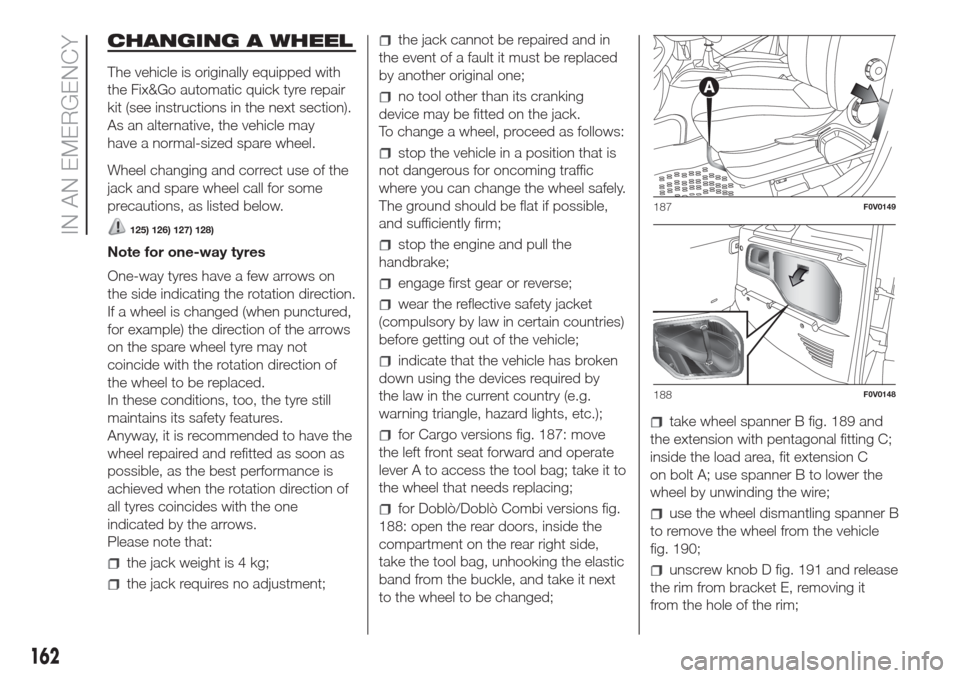
CHANGING A WHEEL
The vehicle is originally equipped with
the Fix&Go automatic quick tyre repair
kit (see instructions in the next section).
As an alternative, the vehicle may
have a normal-sized spare wheel.
Wheel changing and correct use of the
jack and spare wheel call for some
precautions, as listed below.
125) 126) 127) 128)
Note for one-way tyres
One-way tyres have a few arrows on
the side indicating the rotation direction.
If a wheel is changed (when punctured,
for example) the direction of the arrows
on the spare wheel tyre may not
coincide with the rotation direction of
the wheel to be replaced.
In these conditions, too, the tyre still
maintains its safety features.
Anyway, it is recommended to have the
wheel repaired and refitted as soon as
possible, as the best performance is
achieved when the rotation direction of
all tyres coincides with the one
indicated by the arrows.
Please note that:
the jack weight is 4 kg;
the jack requires no adjustment;
the jack cannot be repaired and in
the event of a fault it must be replaced
by another original one;
no tool other than its cranking
device may be fitted on the jack.
To change a wheel, proceed as follows:
stop the vehicle in a position that is
not dangerous for oncoming traffic
where you can change the wheel safely.
The ground should be flat if possible,
and sufficiently firm;
stop the engine and pull the
handbrake;
engage first gear or reverse;
wear the reflective safety jacket
(compulsory by law in certain countries)
before getting out of the vehicle;
indicate that the vehicle has broken
down using the devices required by
the law in the current country (e.g.
warning triangle, hazard lights, etc.);
for Cargo versions fig. 187: move
the left front seat forward and operate
lever A to access the tool bag; take it to
the wheel that needs replacing;
for Doblò/Doblò Combi versions fig.
188: open the rear doors, inside the
compartment on the rear right side,
take the tool bag, unhooking the elastic
band from the buckle, and take it next
to the wheel to be changed;
take wheel spanner B fig. 189 and
the extension with pentagonal fitting C;
inside the load area, fit extension C
on bolt A; use spanner B to lower the
wheel by unwinding the wire;
use the wheel dismantling spanner B
to remove the wheel from the vehicle
fig. 190;
unscrew knob D fig. 191 and release
the rim from bracket E, removing it
from the hole of the rim;
187F0V0149
188F0V0148
162
IN AN EMERGENCY
Page 209 of 300
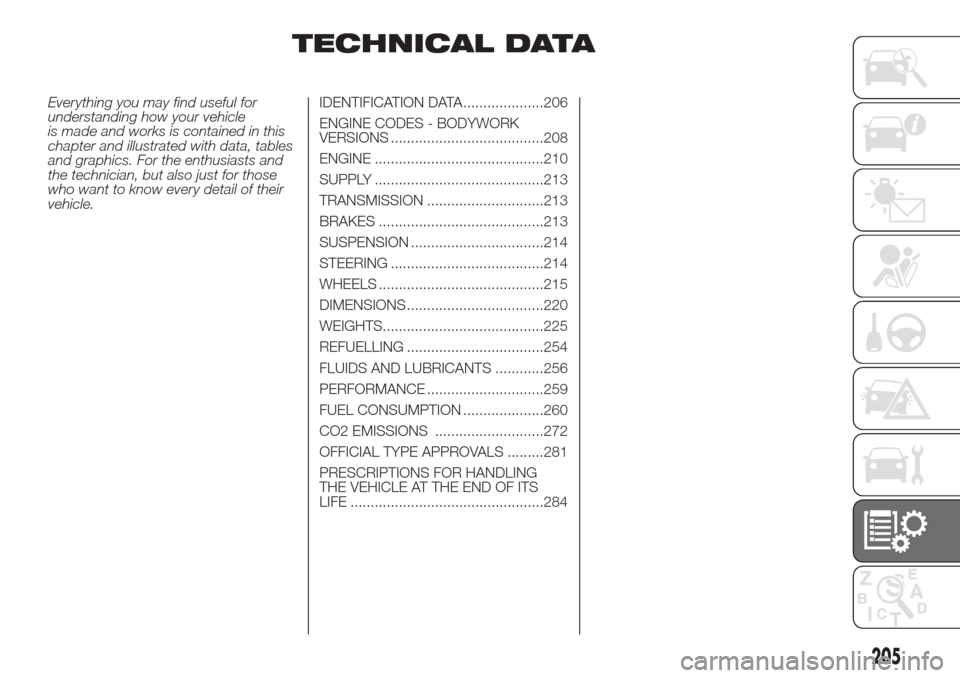
TECHNICAL DATA
Everything you may find useful for
understanding how your vehicle
is made and works is contained in this
chapter and illustrated with data, tables
and graphics. For the enthusiasts and
the technician, but also just for those
who want to know every detail of their
vehicle.IDENTIFICATION DATA....................206
ENGINE CODES - BODYWORK
VERSIONS ......................................208
ENGINE ..........................................210
SUPPLY ..........................................213
TRANSMISSION .............................213
BRAKES .........................................213
SUSPENSION .................................214
STEERING ......................................214
WHEELS .........................................215
DIMENSIONS ..................................220
WEIGHTS........................................225
REFUELLING ..................................254
FLUIDS AND LUBRICANTS ............256
PERFORMANCE .............................259
FUEL CONSUMPTION ....................260
CO2 EMISSIONS ...........................272
OFFICIAL TYPE APPROVALS .........281
PRESCRIPTIONS FOR HANDLING
THE VEHICLE AT THE END OF ITS
LIFE ................................................284
205
Page 210 of 300
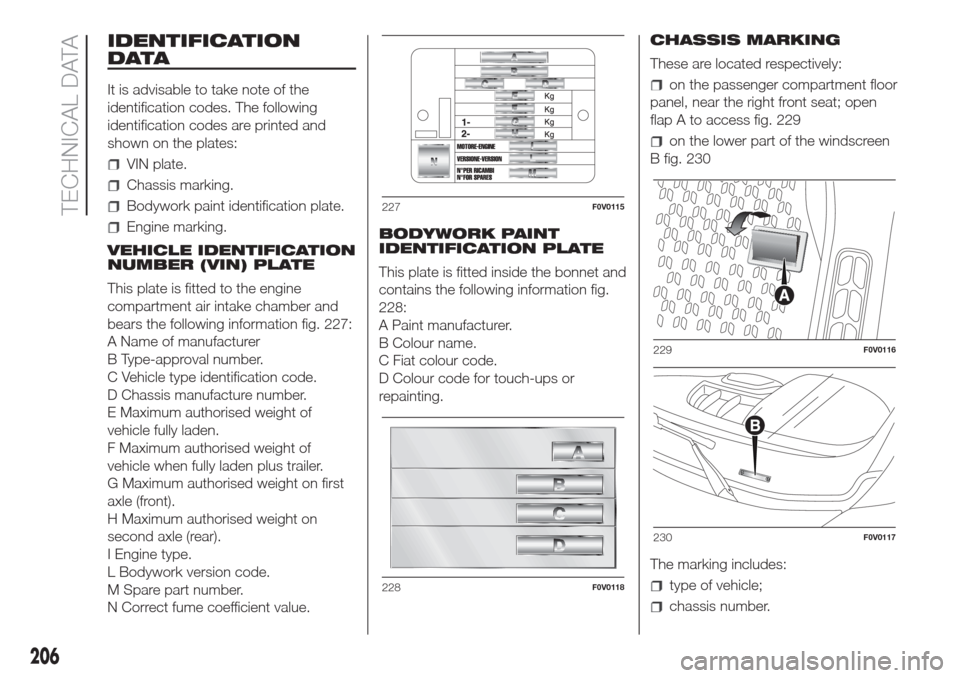
IDENTIFICATION
DATA
It is advisable to take note of the
identification codes. The following
identification codes are printed and
shown on the plates:
VIN plate.
Chassis marking.
Bodywork paint identification plate.
Engine marking.
VEHICLE IDENTIFICATION
NUMBER (VIN) PLATE
This plate is fitted to the engine
compartment air intake chamber and
bears the following information fig. 227:
A Name of manufacturer
B Type-approval number.
C Vehicle type identification code.
D Chassis manufacture number.
E Maximum authorised weight of
vehicle fully laden.
F Maximum authorised weight of
vehicle when fully laden plus trailer.
G Maximum authorised weight on first
axle (front).
H Maximum authorised weight on
second axle (rear).
I Engine type.
L Bodywork version code.
M Spare part number.
N Correct fume coefficient value.BODYWORK PAINT
IDENTIFICATION PLATE
This plate is fitted inside the bonnet and
contains the following information fig.
228:
A Paint manufacturer.
B Colour name.
C Fiat colour code.
D Colour code for touch-ups or
repainting.CHASSIS MARKING
These are located respectively:
on the passenger compartment floor
panel, near the right front seat; open
flap A to access fig. 229
on the lower part of the windscreen
B fig. 230
The marking includes:
type of vehicle;
chassis number.
227F0V0115
228F0V0118
229F0V0116
230F0V0117
206
TECHNICAL DATA
Page 229 of 300
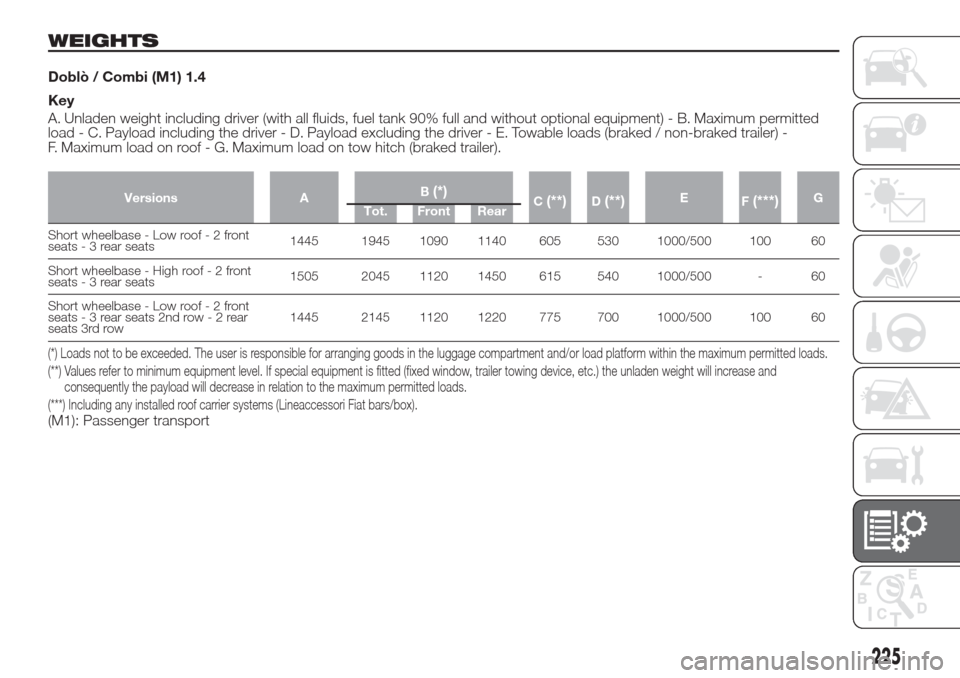
WEIGHTS
Doblò / Combi (M1) 1.4
Key
A. Unladen weight including driver (with all fluids, fuel tank 90% full and without optional equipment) - B. Maximum permitted
load - C. Payload including the driver - D. Payload excluding the driver - E. Towable loads (braked / non-braked trailer) -
F. Maximum load on roof - G. Maximum load on tow hitch (braked trailer).
Versions AB(*)C(**)D(**)E
F(***)G
Tot. Front Rear
Short wheelbase - Low roof-2front
seats-3rearseats1445 1945 1090 1140 605 530 1000/500 100 60
Short wheelbase - High roof-2front
seats-3rearseats1505 2045 1120 1450 615 540 1000/500 - 60
Short wheelbase - Low roof-2front
seats-3rearseats 2nd row-2rear
seats 3rd row1445 2145 1120 1220 775 700 1000/500 100 60
(*) Loads not to be exceeded. The user is responsible for arranging goods in the luggage compartment and/or load platform within the maximum permittedloads.
(**) Values refer to minimum equipment level. If special equipment is fitted (fixed window, trailer towing device, etc.) the unladen weight will increase and
consequently the payload will decrease in relation to the maximum permitted loads.
(***) Including any installed roof carrier systems (Lineaccessori Fiat bars/box).
(M1): Passenger transport
225
Page 230 of 300
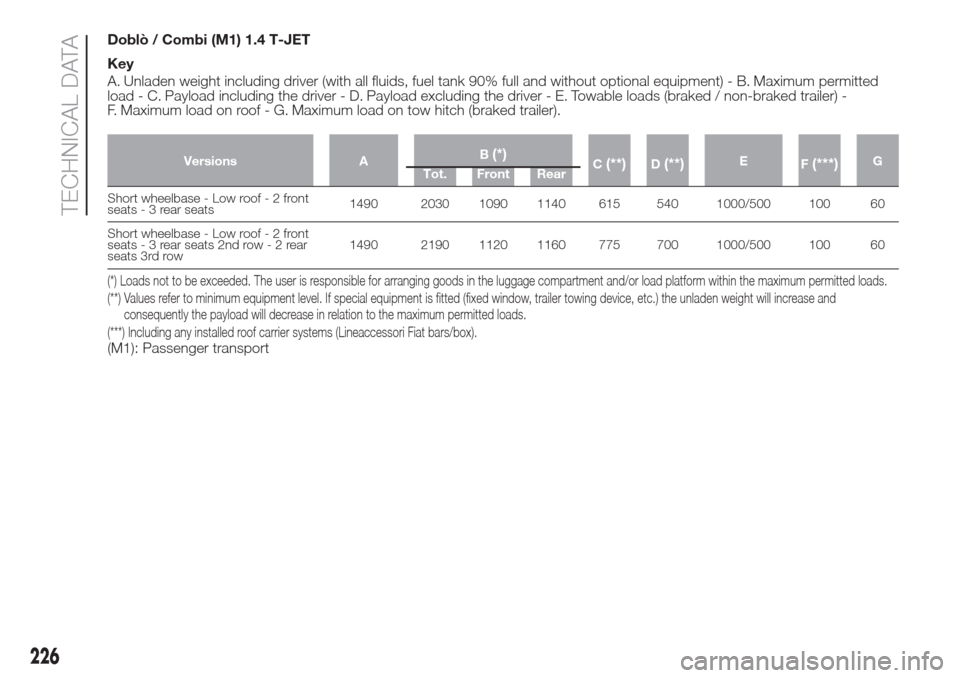
Doblò / Combi (M1) 1.4 T-JET
Key
A. Unladen weight including driver (with all fluids, fuel tank 90% full and without optional equipment) - B. Maximum permitted
load - C. Payload including the driver - D. Payload excluding the driver - E. Towable loads (braked / non-braked trailer) -
F. Maximum load on roof - G. Maximum load on tow hitch (braked trailer).
Versions AB(*)C(**)D(**)E
F(***)G
Tot. Front Rear
Short wheelbase - Low roof-2front
seats-3rearseats1490 2030 1090 1140 615 540 1000/500 100 60
Short wheelbase - Low roof-2front
seats-3rearseats 2nd row-2rear
seats 3rd row1490 2190 1120 1160 775 700 1000/500 100 60
(*) Loads not to be exceeded. The user is responsible for arranging goods in the luggage compartment and/or load platform within the maximum permittedloads.
(**) Values refer to minimum equipment level. If special equipment is fitted (fixed window, trailer towing device, etc.) the unladen weight will increase and
consequently the payload will decrease in relation to the maximum permitted loads.
(***) Including any installed roof carrier systems (Lineaccessori Fiat bars/box).
(M1): Passenger transport
226
TECHNICAL DATA
Page 231 of 300

Doblò / Combi (M1) 1.6 Multijet
Key
A. Unladen weight including driver (with all fluids, fuel tank 90% full and without optional equipment) - B. Maximum permitted
load - C. Payload including the driver - D. Payload excluding the driver - E. Towable loads (braked / non-braked trailer) -
F. Maximum load on roof - G. Maximum load on tow hitch (braked trailer).
Versions AB(*)C(**)D(**)E
F(***)G
Tot. Front Rear
Short wheelbase - Low roof-2front
seats-3rearseats1505 2035 1090 1075 605 530 1300/500 100 60
Short wheelbase - High roof-2front
seats-3rearseats1575 2115 1120 1450 615 540 1300/500 - 60
Short wheelbase - Low roof-2front
seats-3rearseats 2nd row-2rear
seats 3rd row1505 2205 1120 1220 775 700 1300/500 100 60
Long wheelbase - Low roof-2front
seats-3rearseats1600 2105 1200 1310 580 505 1300/500 100 60
Long Wheelbase - High Roof - 2
front seats-3rearseats -
Reinforced Suspension1615 2105 1200 1310 565 490 1300/500 - 60
(*) Loads not to be exceeded. The user is responsible for arranging goods in the luggage compartment and/or load platform within the maximum permittedloads.
(**) Values refer to minimum equipment level. If special equipment is fitted (fixed window, trailer towing device, etc.) the unladen weight will increase and
consequently the payload will decrease in relation to the maximum permitted loads.
(***) Including any installed roof carrier systems (Lineaccessori Fiat bars/box).
(M1): Passenger transport
227
Page 232 of 300
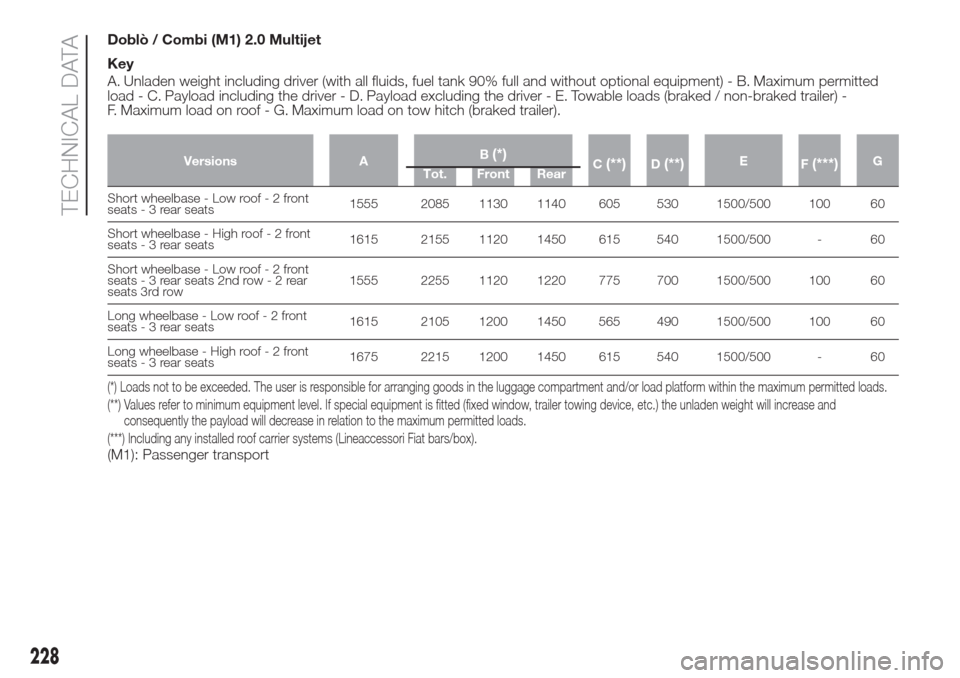
Doblò / Combi (M1) 2.0 Multijet
Key
A. Unladen weight including driver (with all fluids, fuel tank 90% full and without optional equipment) - B. Maximum permitted
load - C. Payload including the driver - D. Payload excluding the driver - E. Towable loads (braked / non-braked trailer) -
F. Maximum load on roof - G. Maximum load on tow hitch (braked trailer).
Versions AB(*)C(**)D(**)E
F(***)G
Tot. Front Rear
Short wheelbase - Low roof-2front
seats-3rearseats1555 2085 1130 1140 605 530 1500/500 100 60
Short wheelbase - High roof-2front
seats-3rearseats1615 2155 1120 1450 615 540 1500/500 - 60
Short wheelbase - Low roof-2front
seats-3rearseats 2nd row-2rear
seats 3rd row1555 2255 1120 1220 775 700 1500/500 100 60
Long wheelbase - Low roof-2front
seats-3rearseats1615 2105 1200 1450 565 490 1500/500 100 60
Long wheelbase - High roof-2front
seats-3rearseats1675 2215 1200 1450 615 540 1500/500 - 60
(*) Loads not to be exceeded. The user is responsible for arranging goods in the luggage compartment and/or load platform within the maximum permittedloads.
(**) Values refer to minimum equipment level. If special equipment is fitted (fixed window, trailer towing device, etc.) the unladen weight will increase and
consequently the payload will decrease in relation to the maximum permitted loads.
(***) Including any installed roof carrier systems (Lineaccessori Fiat bars/box).
(M1): Passenger transport
228
TECHNICAL DATA
Page 233 of 300
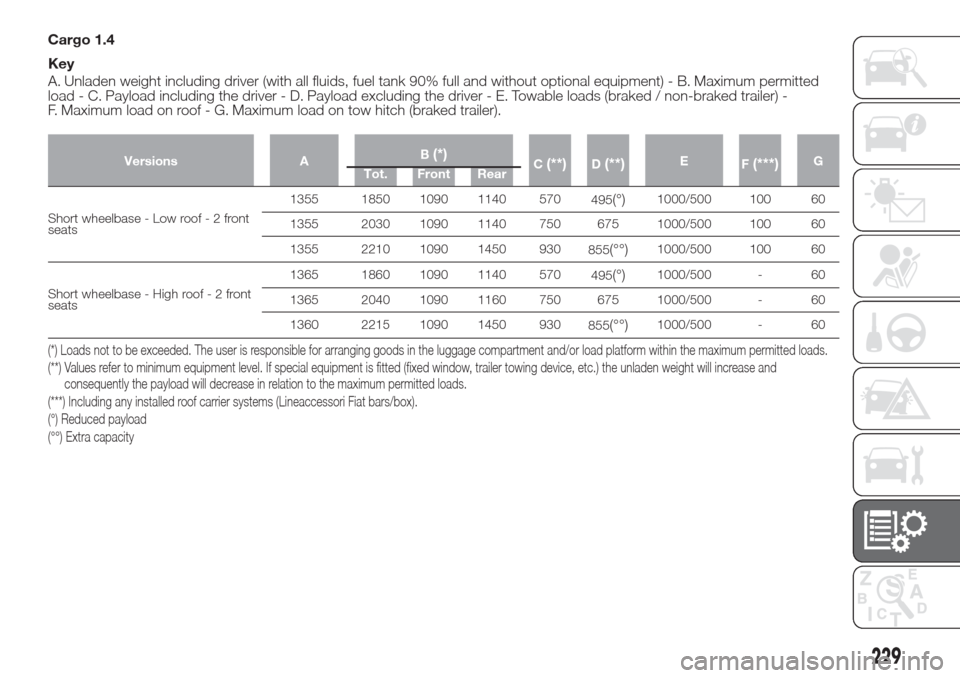
Cargo 1.4
Key
A. Unladen weight including driver (with all fluids, fuel tank 90% full and without optional equipment) - B. Maximum permitted
load - C. Payload including the driver - D. Payload excluding the driver - E. Towable loads (braked / non-braked trailer) -
F. Maximum load on roof - G. Maximum load on tow hitch (braked trailer).
Versions AB(*)C(**)D(**)E
F(***)G
Tot. Front Rear
Short wheelbase - Low roof-2front
seats1355 1850 1090 1140 570
495
(°)1000/500 100 60
1355 2030 1090 1140 750 675 1000/500 100 60
1355 2210 1090 1450 930
855
(°°)1000/500 100 60
Short wheelbase - High roof-2front
seats1365 1860 1090 1140 570
495
(°)1000/500 - 60
1365 2040 1090 1160 750 675 1000/500 - 60
1360 2215 1090 1450 930
855
(°°)1000/500 - 60
(*) Loads not to be exceeded. The user is responsible for arranging goods in the luggage compartment and/or load platform within the maximum permittedloads.
(**) Values refer to minimum equipment level. If special equipment is fitted (fixed window, trailer towing device, etc.) the unladen weight will increase and
consequently the payload will decrease in relation to the maximum permitted loads.
(***) Including any installed roof carrier systems (Lineaccessori Fiat bars/box).
(°) Reduced payload
(°°) Extra capacity
229